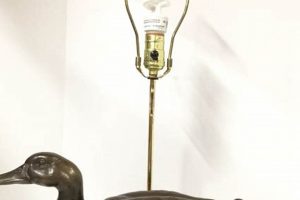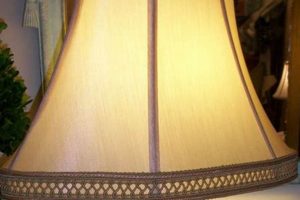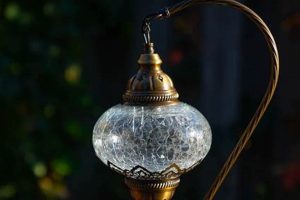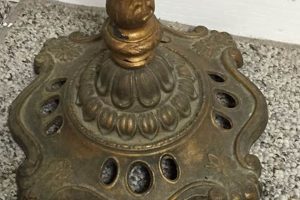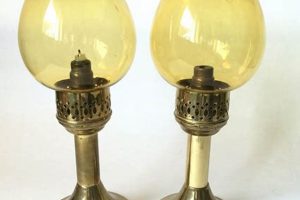Illuminating devices from a bygone era, these artifacts represent a significant period in lighting history. Characterized by their use of liquid fuel to generate light via a wick and chimney, they offer a tangible connection to a time before widespread electrification. Examples include pressed glass lamps from the Victorian era and utilitarian models used in rural settings.
These historical light sources provide more than mere illumination; they offer insights into past lifestyles and technological advancements. Their aesthetic appeal makes them desirable collector’s items, while their functionality can serve as a backup light source during power outages. Moreover, they represent a commitment to resourcefulness and self-sufficiency.
The subsequent sections will delve into the construction, restoration, and appreciation of these historical objects. Discussions will cover topics such as identifying different types, understanding the mechanics of operation, and acquiring necessary maintenance skills.
Tips on Handling Historical Lighting Devices
Proper handling ensures the longevity and safe operation of these delicate items. Attention to detail and adherence to best practices are paramount.
Tip 1: Prioritize Safety. Always exercise extreme caution when handling fuel. Ensure adequate ventilation when operating a lamp and never leave it unattended.
Tip 2: Inspect for Damage. Before each use, thoroughly inspect the lamp for cracks, leaks, or deterioration. A compromised fuel reservoir poses a significant hazard.
Tip 3: Use Appropriate Fuel. Employ only high-quality fuel specifically designed for lamps. Never substitute with gasoline or other volatile substances.
Tip 4: Maintain the Wick. Regularly trim the wick to ensure a clean and consistent flame. A properly maintained wick minimizes smoke and maximizes light output.
Tip 5: Store Fuel Safely. Store fuel in a designated, clearly labeled container away from heat sources and out of reach of children and pets.
Tip 6: Handle with Care. These items are often fragile. Handle them gently and avoid dropping or bumping them against hard surfaces. When moving, support both the base and the font (fuel reservoir) separately to reduce the strain on joints.
Tip 7: Clean Regularly. Clean the lamp regularly to remove dust and soot. Use a soft cloth and appropriate cleaning solutions to avoid damaging delicate finishes or glass components.
By diligently following these recommendations, the safe preservation and enjoyment of these historic light sources will be enhanced.
The following section details the restoration techniques to ensure the proper preservation and operation of historical lighting devices.
1. Construction
The construction of these historical lighting devices is a critical factor in determining their value, authenticity, and functionality. Examining the materials, manufacturing techniques, and design elements reveals insights into the era of production and the intended use of the lamp.
- Material Composition
The materials employed in the lamp’s constructionsuch as brass, glass (pressed, blown, or cut), iron, or spelterdirectly influence its durability and aesthetic appeal. For example, a lamp with a solid brass font and burner typically indicates higher quality and a later production date compared to one made from painted iron or spelter, which was commonly used in mass-produced models. The type and quality of glass used in the chimney and font also serve as indicators of the lamp’s value and production period.
- Manufacturing Techniques
The methods used to assemble the lamp provide valuable clues about its origin and age. Hand-blown glass fonts and individually crafted burners are indicative of earlier, more artisanal manufacturing processes. Mass-produced lamps, on the other hand, often feature machine-stamped metal parts and molded glass components. The presence of hand-applied finishes, such as decorative painting or applied ornamentation, can further distinguish high-quality examples from those intended for utilitarian use.
- Burner Design and Mechanism
The burner is a vital component, dictating the lamp’s efficiency and light output. Different burner designs, such as the Kosmos, Matador, or central draught burners, reflect specific technological advancements and regional preferences. Identifying the burner type is crucial for determining the lamp’s intended fuel and proper operation. Original burners in good working condition significantly enhance a lamp’s value.
- Structural Integrity and Design Features
The overall structural integrity of the lamp and the presence of specific design features contribute to its historical significance. The soundness of the joints, the stability of the base, and the presence of original components all affect its collectibility. Unique design elements, such as decorative motifs, intricate castings, or unusual shapes, can further increase its appeal and rarity.
In conclusion, the construction of these lighting devices reveals a wealth of information about its history, quality, and intended purpose. Careful examination of the materials, manufacturing techniques, burner design, and structural features provides a comprehensive understanding of its historical context and value within the realm of antique collecting.
2. Functionality
Functionality, in the context of historical lighting devices, pertains to the ability of these objects to effectively provide illumination. The design and operation of these lamps were meticulously engineered to maximize light output while ensuring safe and reliable performance. Understanding the functional aspects is essential for appreciating their historical significance and practical application.
- Illumination Capacity
The primary function centered on providing a steady and sufficient light source. Light output, measured in candlepower, depended on the burner design, wick size, and fuel quality. Some lamps were designed for general ambient lighting, while others focused on directional or task lighting. For instance, a central-draft lamp with a larger wick and specialized chimney produced greater illumination than a smaller, simpler model. This dictated its utility in larger spaces or for tasks requiring enhanced visibility.
- Fuel Consumption Efficiency
Efficient fuel consumption was a crucial design consideration, given the cost and availability of fuel. Lamp designs aimed to optimize light output per unit of fuel consumed. Factors influencing efficiency included burner design, wick material, and chimney construction, all contributing to complete combustion and minimal waste. For example, lamps with properly fitted chimneys and efficient burners provided longer periods of illumination per fuel filling, reducing the need for frequent refueling and minimizing operational costs.
- Safety Mechanisms
Safety was paramount in the design and operation of these lamps. Stability features, such as wide bases and secure fuel reservoirs, were incorporated to prevent accidental tipping and fuel spillage. Flame arrestors and chimney designs minimized the risk of fire or explosion. For example, lamps with weighted bases and secure burner assemblies were less prone to tipping, and those with proper ventilation mitigated the risk of overheating or combustion instability. These mechanisms ensured user safety and prevented potential hazards associated with open-flame lighting.
- Ease of Maintenance
Practicality extended to the ease with which lamps could be maintained and operated. Simplicity in design allowed for easy cleaning, wick trimming, and fuel refilling. Readily accessible components and straightforward mechanisms ensured that users could efficiently maintain the lamp in proper working condition. Lamps with easily removable burners and chimneys facilitated routine cleaning and maintenance, extending their lifespan and ensuring consistent performance with minimal effort.
These elements of functionality directly influenced their adoption and widespread use throughout the 19th and early 20th centuries. Their design reflected a balance between effective illumination, safety, efficiency, and user-friendliness, features which continue to underscore their significance as historical artifacts and functional objects.
3. Design Era
The design era significantly influences the aesthetic and functional characteristics of historical lighting devices. The prevailing styles, technological advancements, and social norms of each period shaped the form, materials, and construction of these lamps, providing valuable insights into their historical context.
- Victorian Era (1837-1901)
Lamps from this era often exhibit ornate designs, reflecting the Victorian penchant for embellishment. Common features include pressed glass fonts with intricate patterns, brass burners with decorative detailing, and elaborate shades. Examples include banquet lamps with hand-painted floral motifs and parlor lamps with cut-glass fonts, demonstrating the era’s focus on opulence and refined craftsmanship. These lamps served as status symbols, reflecting the affluence and taste of their owners.
- Art Nouveau (1890-1910)
Characterized by flowing lines, organic motifs, and the use of new materials, this design movement influenced the creation of lamps featuring stylized floral designs, whiplash curves, and asymmetrical forms. Favrile glass, patented by Louis Comfort Tiffany, was frequently used to create lamps with iridescent surfaces and naturalistic patterns. Examples include lamps with dragonfly or peacock feather motifs, illustrating the movement’s emphasis on nature and artistic expression. These lamps bridged the gap between functional lighting and decorative art.
- Art Deco (1920s-1930s)
This era favored geometric shapes, streamlined designs, and modern materials such as chrome and Bakelite. Lamps from this period often feature stepped bases, angular fonts, and bold color combinations. Examples include skyscraper lamps with chrome accents and geometric patterns, reflecting the era’s fascination with industrial progress and urban modernity. These lamps conveyed a sense of sophistication and technological advancement.
- Mid-Century Modern (1940s-1960s)
Emphasizing functionality and simplicity, this design movement produced lamps with clean lines, minimalist forms, and the use of materials such as wood, metal, and plastic. Examples include lamps with tripod bases, adjustable shades, and understated designs, showcasing the era’s focus on practicality and affordability. These lamps reflected the post-war emphasis on suburban living and efficient design.
The design era imprints a distinctive signature upon each historical lighting device, influencing its aesthetic appeal, functional characteristics, and historical value. Identifying the design era is crucial for understanding the lamp’s cultural context and appreciating its place within the broader history of decorative arts and technology.
4. Fuel Source
The liquid fuel, specifically kerosene, represents a defining characteristic of these vintage lighting devices. Its use establishes a direct cause-and-effect relationship between the fuel’s properties and the lamp’s operational capabilities. Without kerosene, these lamps are rendered inoperable, highlighting the fuel source’s indispensable role. A historical example illustrates this point: the widespread adoption of kerosene lamps in the mid-19th century was contingent upon the availability of affordable and readily obtainable kerosene derived from petroleum. This transition marked a significant shift from more expensive and less efficient fuel sources like whale oil or camphene. Understanding this connection has considerable practical significance; using an inappropriate fuel, such as gasoline, can lead to dangerous outcomes, including explosions or fires, emphasizing the need for historically accurate and safe practices in their maintenance and operation. The practical significance underscores the importance of verifying fuel compatibility before operation.
Further analysis reveals that the quality of the kerosene directly impacted the lamp’s performance. Impurities in the fuel could lead to incomplete combustion, resulting in smoky flames and reduced light output. Consequently, kerosene refining processes evolved to produce cleaner and more efficient fuels, directly improving the lamps’ utility and safety. The evolution of the kerosene distillation methods is a compelling example, improved the refining to produced cleaner fuel that also improved the lamp’s utility and safety. The evolution of kerosene refining methods showcases the critical interplay between fuel technology and lamp design, optimizing the lighting experience while minimizing hazards.
In summary, the fuel source, kerosene, is not merely an incidental component but rather an intrinsic element defining these vintage lighting devices. Its properties dictate the lamp’s functionality, safety, and efficiency, while historical context reveals the profound impact of kerosene availability and quality on lamp design and usage. Recognizing this connection is crucial for responsible preservation, restoration, and operation, ensuring that these artifacts continue to illuminate the past safely and effectively.
5. Rarity
The degree of scarcity inherently affects the desirability and value of historical lighting devices. Several factors contribute to the infrequency of particular lamps, directly impacting their collectibility. Limited production runs, specialized designs intended for specific purposes, and the fragility of materials contribute to a lamp’s infrequent availability. For example, a model produced for a single year to commemorate a historical event inherently possesses greater scarcity than mass-produced utilitarian lamps. This scarcity directly affects the lamp’s market value and appeal to collectors. The cause of this scarcity is varied but the effect is universal: increased desirability.
Further analysis reveals that condition and provenance amplify the influence of scarcity. A lamp may be inherently rare due to its limited production, but its value is significantly diminished if it is damaged or lacks documentation of its history and ownership. Conversely, a reasonably rare lamp in excellent condition with documented provenance, such as a history of ownership by a notable figure or use in a significant historical setting, commands a premium among collectors. As a practical application, authentication and detailed documentation become crucial when dealing with purportedly rare lamps. Verification by expert appraisers and historical societies can validate claims of scarcity and establish the lamp’s historical significance, influencing its market value. Therefore, establishing the provenance of such lamps enhances the interest and value to historians and collectors of such vintage items, by authenticating claims made about such items.
In conclusion, scarcity acts as a primary driver of value within the realm of vintage kerosene lamps. The limited availability, compounded by condition and provenance, significantly impacts desirability. Collectors and historians must prioritize authentication and meticulous documentation to accurately assess the rarity and historical significance of these artifacts. Overcoming the challenges of fraudulent claims and incomplete historical records requires diligent research and expert consultation, ensuring the preservation and accurate valuation of these illuminating remnants of the past. Therefore, preservation and proper understanding of scarcity of vintage kerosene lamps are key to understanding its overall value.
6. Condition
The state of preservation significantly influences the value, functionality, and historical integrity of historical lighting devices. Assessment encompasses a comprehensive examination of physical attributes and operational capacity, revealing the extent of deterioration or restoration efforts.
- Structural Integrity
The presence of cracks, chips, or fractures in glass or metal components directly affects both the aesthetic appeal and the safe operation of the lamp. For example, a hairline fracture in the fuel reservoir increases the risk of leakage and potential fire hazard. Lamps with compromised structural integrity are typically valued lower due to the diminished aesthetic and potential safety concerns.
- Originality of Components
The degree to which the lamp retains its original parts, including the burner, wick adjuster, chimney, and shade, significantly impacts its historical authenticity and collectibility. Replacement of original components with modern substitutes reduces the lamp’s value and historical significance. A lamp with a complete set of original, unaltered components commands a higher premium than one with replacement parts.
- Surface Finish and Patina
The condition of the surface finish, whether it be painted, plated, or left bare, contributes to the lamp’s overall aesthetic appeal. The presence of original patina, a natural aging process, can enhance the lamp’s character and historical value. However, excessive corrosion or damage to the surface finish diminishes the lamp’s visual appeal and can detract from its value. Preservation of the original surface, when possible, is highly valued by collectors.
- Operational Functionality
The lamp’s ability to function as intended, providing a steady and safe source of light, is a critical aspect of its overall condition. A lamp with a damaged burner, a malfunctioning wick adjuster, or a leaking fuel reservoir is considered to be in poor condition, regardless of its aesthetic appeal. Restoration of operational functionality, while preserving original components whenever possible, enhances the lamp’s value and utility.
These facets of condition serve as key determinants of historical and monetary value. The careful assessment of structural integrity, component originality, surface finish, and operational functionality provides a comprehensive understanding of the lamp’s state of preservation, enabling informed decisions regarding conservation, restoration, and valuation. Proper assessment enhances the lamps place as an historically relevant item.
7. Provenance
Provenance, denoting the documented history of ownership and origin, is a crucial factor in evaluating historical lighting devices. It provides a verifiable chain of custody, enhancing the authenticity and historical significance of each artifact. Establishing provenance requires meticulous research and documentation, linking the lamp to specific individuals, events, or locations.
- Ownership History
Tracing the ownership of a lamp reveals its journey through time and provides context for its existence. Direct links to notable historical figures or significant events can elevate the lamp’s value and historical importance. For example, a lamp demonstrably owned by a prominent inventor or used in a historically significant location gains heightened significance. The documented ownership history adds an undeniable layer of interest and value.
- Manufacturing Records
Original manufacturing records, if available, can provide critical information about the lamp’s production details, including the date of manufacture, materials used, and intended market. These records can confirm the lamp’s authenticity and provide insights into the manufacturing practices of the period. Surviving catalogs or advertisements featuring the lamp can further corroborate its provenance and historical context. Such resources enhance the lamps’ collectibility to historians and vintage collectors alike.
- Auction and Sales Records
Auction and sales records offer verifiable evidence of the lamp’s passage through the market. These records often include detailed descriptions, photographs, and price information, providing valuable insights into the lamp’s condition and value at different points in time. Tracing the lamp through auction houses and private sales establishes a clear timeline of ownership and adds credibility to its provenance. Having official documentation adds value in many collectors’ circles.
In conclusion, provenance serves as a cornerstone in the appreciation and valuation of historical lighting devices. A well-documented provenance enhances the lamp’s historical significance, confirms its authenticity, and increases its desirability among collectors and historians. Careful attention to establishing and preserving provenance is essential for safeguarding the legacy of these artifacts and ensuring their continued appreciation for generations to come.
Frequently Asked Questions
The following addresses common inquiries regarding the identification, operation, maintenance, and historical significance of these lighting devices.
Question 1: How can the age of a vintage kerosene lamp be determined?
Determining the age involves assessing manufacturing techniques, design elements, and material composition. Pressed glass fonts, for example, are indicative of mass-produced lamps from the late 19th century. Specific burner types, such as Kosmos or Matador, also correlate with particular periods of production. Consulting historical catalogs and patent records can further refine the estimation.
Question 2: What type of fuel is appropriate for vintage kerosene lamps?
Only use high-quality fuel specifically designated for kerosene lamps. Substituting with gasoline, alcohol, or other volatile substances is extremely dangerous and can result in explosions or fires. Always verify fuel compatibility before operation.
Question 3: How should a vintage kerosene lamp be cleaned?
Clean the lamp using a soft cloth and mild detergent. Avoid abrasive cleaners or harsh chemicals, as they can damage delicate finishes or glass components. Remove the burner and wick assembly for thorough cleaning. Ensure all components are completely dry before reassembling the lamp.
Question 4: Is it safe to operate a vintage kerosene lamp indoors?
Operating a kerosene lamp indoors requires adherence to strict safety precautions. Ensure adequate ventilation to prevent the accumulation of carbon monoxide. Never leave a lit lamp unattended. Position the lamp on a stable, non-flammable surface away from curtains or other combustible materials. Maintain a working smoke detector in the vicinity.
Question 5: How does one identify a valuable vintage kerosene lamp?
Identifying a valuable lamp involves evaluating rarity, condition, provenance, and aesthetic appeal. Lamps with documented historical significance, original components, and unique designs command higher prices. Consulting with experienced appraisers and researching auction records can assist in determining the lamp’s market value.
Question 6: What are the key considerations when restoring a vintage kerosene lamp?
Restoration requires a careful balance between preserving original components and ensuring safe functionality. Prioritize repairing rather than replacing original parts. Employ historically appropriate materials and techniques. Seek professional assistance when dealing with complex repairs or potentially hazardous materials. Document all restoration efforts to maintain the lamp’s historical record.
Understanding these aspects facilitates the responsible ownership, operation, and preservation of these artifacts, ensuring their continued appreciation and functionality.
The subsequent section will explore potential safety hazards associated with vintage kerosene lamps.
Vintage Kerosene Lamps
This exploration of vintage kerosene lamps has underscored their multifaceted significance, encompassing historical value, aesthetic appeal, and practical functionality. The discussion has ranged from material construction and design eras to operational principles, safety considerations, and valuation determinants. Emphasized throughout has been the importance of discerning original components, ensuring safe operational practices, and verifying provenance to preserve the integrity and appreciate the true worth of these artifacts.
Given the inherent risks associated with flammable fuels and the irreplaceable nature of these historical objects, responsible ownership demands diligence in maintenance, operation, and preservation. Continued research, meticulous documentation, and adherence to established safety protocols are essential for ensuring that these illuminating relics of the past continue to inform and inspire future generations. A commitment to responsible stewardship safeguards their historical legacy.



